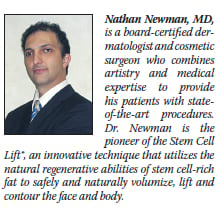Among the many applications for stem cells in the world of cosmetic enhancement, their power to heal scars is among the most remarkable
WORDS J.P. Faber


The result was a great deal of physical and emotional discomfort for Mikaelian. “The cancer didn’t kill me, but the scar tissue was horrible. Whoever would look at me would look at the side of my face and not at me,” he says.
After years of undergoing special treatments and seeing no results, Mikaelian’s doctors finally told him what he feared the most: There was no hope. “I was devastated, sad. It felt like I had lost the war. I thought to myself, am I going to live like this for the rest of my life?”
Completely discouraged, he heard about Dr. Nathan Newman, a cosmetic surgeon in Beverly Hills, Calif., and the power of stem cells, but couldn’t bring himself to feel very optimistic.
“I came to Dr. Newman and said, ‘Hey, I have this problem, and no one can help me,’” recalls Mikaelian. “He said, ‘I’m not sure if it will work, but we’ll try to do it with stem cells.’ I was ready to try anything, so we began.”
Stem Cell Solution

“He had gone to all the doctors,” says Dr. Newman. “They had tried to reconstruct the area, but the skin there couldn’t get blood flow. [Any new graft] would start to die, even with filler.” So Dr. Newman began a program of monthly stem cell injections, slowly bringing the area back to life.
“I would inject from healthy tissue toward the center of the defect. It was so scarred that nothing could go there,” he says. “As we put [stem cells] in, the skin surface started to look better. Blood vessels were being created, and you could see the skin start to improve. Eventually it was good enough so that I could graft fat into the area.”
Adult stem cells, primarily mixed with a patient’s fat, are being increasingly used today to help rebuild unsightly scars. In the past, doctors simply injected fat to ‘plump up’ the area of a sunken scar. Then researchers noticed an unexpected result—that, in some cases, the skin tissue began to improve, to actually heal itself.
Not until the last decade did the medical community realize what was happening: That stem cells in the fat were creating networks of tiny blood vessels. When the fat was later treated to activate more of these ‘adipose’ stem cells, the process was dramatically enhanced. The reason: While stem cells typically take on the characteristics of the tissue where they are injected, the first thing they do is build a network of tiny blood vessels.
“What we are seeing with stem cells is that they bring in a new blood supply,” says Sydney Coleman, MD, one of the early pioneers of facial fat grafting. “Before anything else you need that.” It was Dr. Coleman who, almost 20 years ago, published his findings that fat injections seemed to improve the condition of skin, rather than just fill it in.
“Early on I noticed that the overall quality of the skin would improve—its volume, its color, the wrinkling, even pores decreased in size,” he says. “The next big thing I noticed, in 1993, was that scars improve, or disappear, way beyond what was expected.”
Scar Tissue Issues
Fast forward to Mikaelian’s case, which took two years for his face to return to normal. “It was one of the hardest cases I’ve ever done, but very rewarding,” says Dr. Newman. Other patients with scars experience much shorter recovery times, sometimes with as few as one procedure. Mikaelian’s scars were of a different magnitude.
“There are different kinds of scarring. Some are easily reversed. But, there is scarring that comes from burns, where the skin [layers] stick to each other, and it’s glued to the lower skin levels… that was Mikaelian, and that’s why they couldn’t do anything for him,” he says.
“The scar tissue felt like leather,” Mikaelian recalls. “Even with a 16-gauge needle, you could jab me and it wouldn’t penetrate the scar tissue.”
Doctors Newman and Coleman both caution that the type of scar most suitable for treatment with stem cell-rich fat is the sunken type—acne scars, for instance—rather than a raised scar.
“For scars that are indented, we can fill them with the stem cells and they will look better,” says Dr. Newman. “For the raised ones, you have to use lasers; the stem cells won’t shrink them.”
What was most amazing, says Dr. Newman, was how the stem cells took on the characteristics of the face. “The jaw line, if you feel it, is hard like bone, but soft up above, like it’s supposed to be. So the stem cells got hard where the jaw was supposed to be hard,” he says. “Now you can’t tell the difference.”
“Dr. Newman was able to create a face that was 95 percent perfect, which other doctors said was impossible,” says Mikaelian. “The other doctors that saw me afterwards asked: ‘What happened? Who did it and how did he do it?’ He proved the impossible could be done.”












